We may not have the course you’re looking for. If you enquire or give us a call on 01344203999 and speak to our training experts, we may still be able to help with your training requirements.
Training Outcomes Within Your Budget!
We ensure quality, budget-alignment, and timely delivery by our expert instructors.
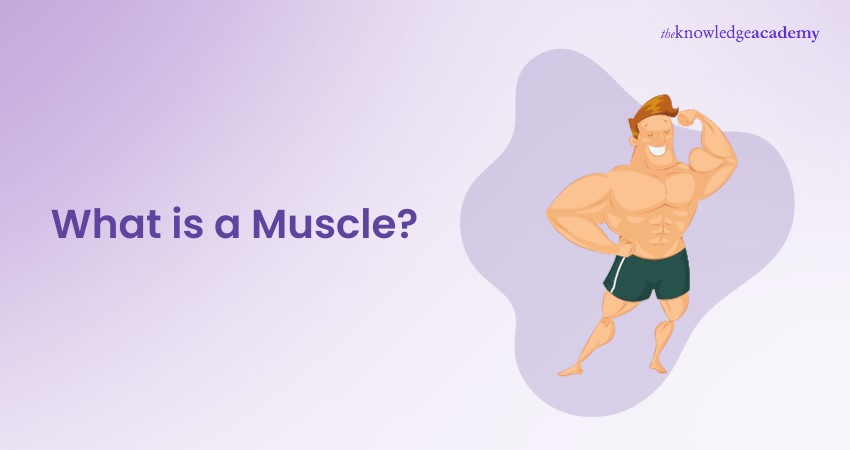
Muscles play a crucial role in every movement, from the simplest gestures to the most complex physical feats. So, anyone who wishes to know the intricacies surrounding the way Muscles work must understand their intricacies. In this blog, you will learn What is a Muscle, its importance, shedding light on its role in maintaining our body's equilibrium.
Table of Contents
1) Understanding What is a Muscle
2) What are the different types of Muscles?
a) Skeletal Muscles
b) Cardiac Muscles
c) Smooth Muscles
3) Functions of a Muscle
4) What are some conditions and disorders impacting Muscles?
5) How do Muscles respond during and after exercise?
6) Conclusion
Understanding What is a Muscle
A Muscle is a vital component of the human body, encompassing tissues that contract and expand to facilitate movement. Comprising fibres, tendons, and blood vessels, Muscles work in tandem with the skeletal system to execute various functions, from voluntary actions like walking to involuntary processes like heartbeat regulation.
Skeletal muscles, attached to bones by tendons, enable voluntary movements, providing the body with its structural framework. Smooth muscles, found in internal organs such as the digestive tract, function involuntarily, aiding processes like digestion. Cardiac muscles, exclusive to the heart, ensure its continuous rhythmic beating.
Muscles respond to signals from the nervous system, contracting and relaxing through intricate biochemical processes. Regular exercise strengthens Muscles, enhancing overall health and functionality. Thus, it's crucial to know What is a Muscle for grasping the complexities of human physiology and promote a holistic approach to well-being.

What are the different types of Muscles?
After understanding What is a Muscle, it’s time to learn about its different types. The human body has three main types of Muscles: skeletal, cardiac, and smooth. Each type has different characteristics, functions, and locations. Let's have a close look at each one of them:
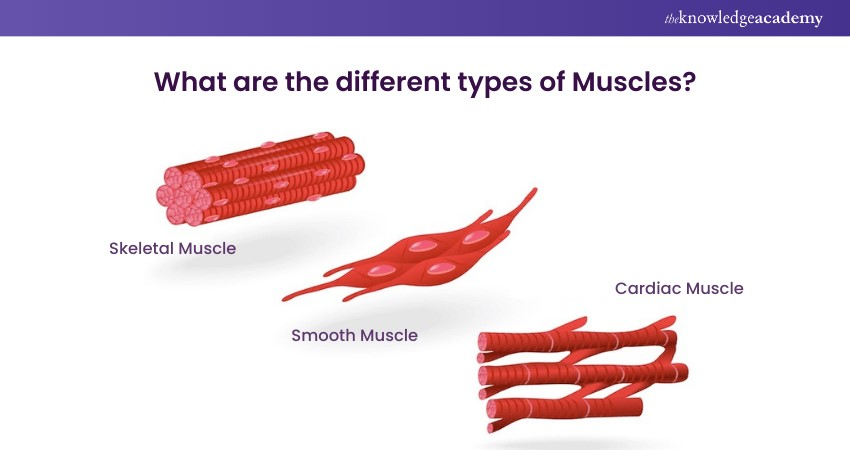
Skeletal Muscles
Skeletal Muscles are the ones that can be consciously controlled. These include the biceps, triceps, quadriceps, and hamstrings. Connected to bones by tendons, these Muscles facilitate various movements like walking, running, lifting, and throwing.
Recognised as Striated Muscles due to their striped appearance under a microscope, this results from the orderly arrangement of Actin and Myosin filaments in Myofibrils. Moreover, they comprise of two types of fibres - Fast-twitch and Slow-twitch.
Fast-twitch fibres contract rapidly but tire quickly, making the Muscles suitable for activities demanding speed and strength like sprinting. In contrast, Slow-twitch fibres contract gradually with more endurance, which is ideal for stamina-demanding activities like jogging and cycling.
Cardiac Muscles
Cardiac Muscles form the walls of the heart. Their role involves circulating blood throughout the entire body. Cardiac Muscles are also Striated but differ from Skeletal Muscles in the following ways:
First, Cardiac Muscles are involuntary, meaning they cannot be consciously controlled. They are regulated by the Autonomic Nervous System, which adjusts the heart rate and force of contraction according to the body’s needs.
Second, Cardiac Muscles are connected by intercalated discs, specialised junctions that allow electrical impulses to pass from one cell to another. It enables them to contract in a coordinated and rhythmic manner, creating a heartbeat.
Third, Cardiac Muscles exhibit a high concentration of Mitochondria, the cellular organelles responsible for generating energy. It allows these Muscles to work continuously without getting tired.
Smooth Muscles
Smooth Muscles line the walls of various organs and vessels, such as the stomach, intestines, bladder, uterus, and blood vessels. They are responsible for performing functions such as digestion, urination, childbirth, and blood pressure regulation.
Smooth Muscles are also involuntary; the Autonomic Nervous System, hormones, and local factors control them. These are not striated because they have different Actin and Myosin filaments in the Myofibrils. They can contract slowly and sustainably and adapt to changes in length and tension.
Ignite vitality with our Active and Healthy Lifestyles Training – join now for a vibrant, well-balanced life!
Functions of a Muscle
Muscles play an important role in the human body. Some of their essential functions involve the following:
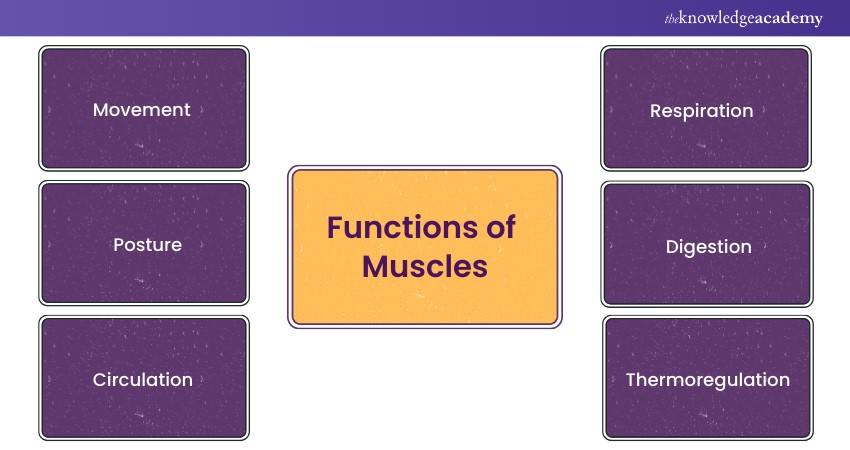
a) Movement: Muscles enable us to move our limbs, head, trunk, and facial expressions. They also allow us to perform sports, dance, and music activities.
b) Posture: Muscles help us maintain a stable and upright position and balance our body against gravity. They also support our joints and bones and prevent injuries and deformities.
c) Circulation: They help circulate blood and lymph throughout the body by contracting and relaxing the blood vessels and the heart. They also assist in the return of blood from the lower extremities to the heart by squeezing the veins when we walk or exercise.
d) Respiration: Muscles help us to breathe by expanding and contracting the chest and abdomen. They also help us to cough, sneeze, and speak by controlling the airflow through the lungs and the vocal cords.
e) Digestion: They aid in digesting food by moving it along the gastrointestinal tract. They also help us to swallow, vomit, and defecate by controlling the openings of the mouth, stomach, and anus.
f) Thermoregulation: They also assist in regulating our body temperature by producing heat when they contract. They also help us to shiver, sweat, and goosebumps by activating the skin and hair follicles.
What are some conditions and disorders impacting Muscles?
Muscles can be affected by various conditions and disorders, some of which are as follows:
Muscle strain
A Muscle strain is an injury resulting from the overstretching or tearing of a Muscle, typically caused by excessive or incorrect use. Symptoms may include pain, swelling, bruising, and a limited range of motion. Treatment options for Muscle strains often involve applying ice, taking rest, using compression, elevating the affected area, and using pain relievers.
Muscle cramp
A sudden and involuntary Muscle contraction characterises a Muscle cramp. It can cause intense pain, stiffness, and spasms. Muscle cramps can be relieved by stretching, massaging, hydrating, and replenishing electrolytes. They usually subside within a few minutes, but recurrent or prolonged cramps may indicate an underlying condition.
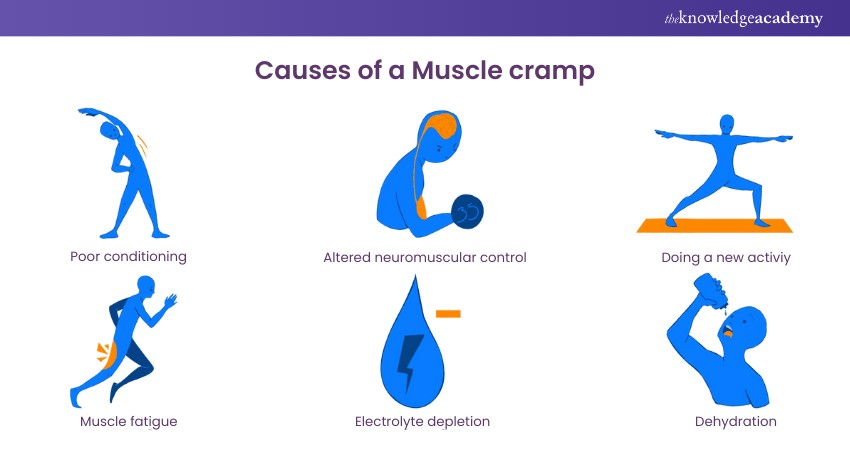
Muscular dystrophy
Muscular dystrophy comprises a cluster of genetic disorders leading to the gradual weakening and deterioration of skeletal Muscles. It can affect various Muscles in the body and impair functions such as movement, breathing, and heart function. There is no cure for muscular dystrophy, but treatments can include medication, physical therapy, surgery, and assistive devices. The prognosis and life expectancy depend on the type and severity of the disorder.
Myasthenia gravis
Myasthenia gravis is an autoimmune condition disrupting normal communication between nerves and Muscles. It can affect various Muscles in the body and impair functions such as eye movement, facial expression, swallowing, and speech. It can also cause drooping eyelids, double vision, fatigue, and difficulty breathing. There is no cure for myasthenia gravis, but treatments can include medication, surgery, and immunotherapy. Symptoms can vary in intensity, ranging from mild to severe, and may exacerbate with factors such as stress, infection, or medication.
Polymyositis
Polymyositis is an inflammatory disorder that causes Muscle weakness and damage, usually due to an immune system attack. It can affect various Muscles in the body, especially those in the shoulders, hips, neck, and back. It can also cause fever, weight loss, difficulty swallowing and breathing.
The cause of Polymyositis is unknown, but it may be triggered by infection, medication, or cancer. Polymyositis lacks a cure, but treatment options encompass medications, physical therapy, and immunosuppressive measures. The prognosis and recovery depend on the extent and response to treatment.
Elevate your well-being through Nutrition and Fitness Training – Join us to sculpt a balanced, vibrant lifestyle today!
How do Muscles respond during and after exercise?
Exercise is a form of physical activity that challenges the Muscles and improves their function and health. During exercise, the Muscles undergo various changes, such as the following:
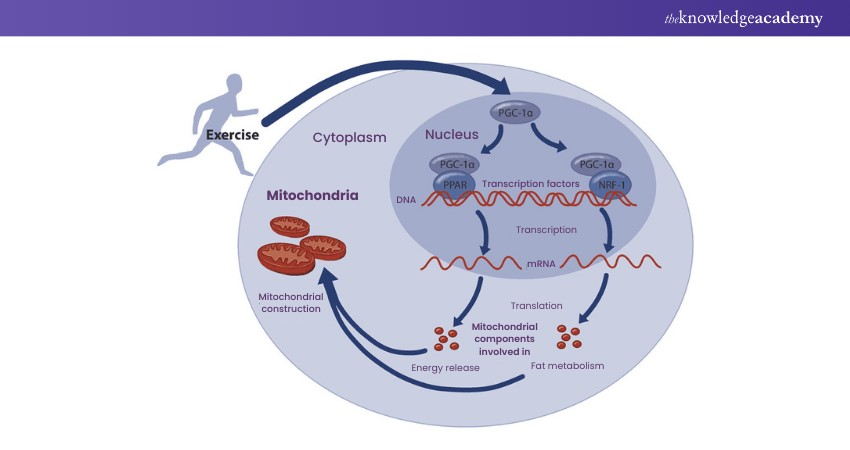
a) Increased blood flow: Exercise increases the demand for oxygen and nutrients in the Muscles, prompting blood vessels to widen and supplying an increased blood flow to the active Muscles. This process aids in the elimination of waste products and carbon dioxide from the Muscles and regulates the body temperature.
b) Increased energy production: Exercise increases the rate of cellular respiration in the Muscles, which converts glucose and fatty acids into Adenosine Triphosphate (ATP), the main energy source for the Muscles. It also produces lactic acid, which can cause Muscle fatigue and soreness.
c) Increased Muscle fibre recruitment: Exercise activates more motor units in the Muscles, which increases the number of Muscle fibres that contract and produce force. It also increases Muscle strength and power.
d) Increased Muscle hypertrophy: Exercise causes microscopic tears in the Muscle fibres, stimulating the Muscle cells to grow and repair themselves. It increases the size and number of the Muscle fibres and the amount of connective tissue and blood vessels in the Muscles. It also increases the Muscle mass and density.
After exercise, the Muscles undergo various changes in the following ways:
a) Decreased blood flow: After exercise, the demand for oxygen and nutrients in the Muscles decreases. This leads to the constriction of blood vessels and a subsequent decrease in blood flow to the Muscles. It also helps to prevent blood pooling and fainting.
b) Decreased energy production: After exercise, the rate of cellular respiration in the Muscles decreases, which reduces the consumption of glucose and fatty acids and the production of ATP and lactic acid. It also helps restore the Muscles' energy balance and pH level.
c) Decreased Muscle fibre recruitment: After exercise, the activation of motor units in the Muscles decreases, which reduces the number of Muscle fibres that contract and produce force. It also reduces the Muscle tension and stiffness.
d) Decreased Muscle hypertrophy: After exercise, the Muscle cells continue to grow and repair themselves, which increases the size and number of the Muscle fibres and the amount of connective tissue and blood vessels in the Muscles. It also increases the Muscle mass and density. However, this process can take several days or weeks, depending on the intensity and duration of the exercise and the nutrition and recovery of the individual.
Elevate your well-being: Join our Healthy Lifestyles Training for a healthier, happier you.
Conclusion
We hope that after reading this blog, you have understood everything about What is a Muscle. Understanding the significance of Muscles in our daily lives, from movement to internal processes, highlights their vital role. So, the next time you marvel at an athlete's capabilities or simply lift a bag of groceries, remember the silent power of Muscles.
Transform your health with our Nutrition Training – start your journey to a nourished, thriving life!
Frequently Asked Questions
Upcoming Batches & Dates
Date








 Top Rated Course
Top Rated Course


 If you wish to make any changes to your course, please
If you wish to make any changes to your course, please


